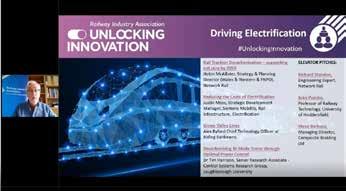
18 minute read
Hydrogen trains coming soon?
DAVID SHIRRES HYDROGEN TRAINS coming soon?

HydroFLEX, the UK’s first hydrogen train takes to the mainline on 30 September.
If Britain’s transport is to stop using petroleum, electricity is the only alternative practical method of supplying vehicles with the huge amount of energy they use. In 2018, UK transport consumed 55.2 million tonnes of oil whilst the nation’s total electricity consumption (not just transportation) was equivalent to 30.1 million tonnes of oil. Electricity can also be produced from zero-carbon energy sources.
Electric trains are the most efficient way of using electricity as these are the only vehicles that can be directly powered by it. Other vehicles need to store and carry electrical energy before they can use it. Although this is normally done by batteries, hydrogen trains can also store electrical energy. This is because hydrogen can be produced by electrolysis, which uses electricity to split water into hydrogen and oxygen. A hydrogen train’s fuel cells can then use it to generate electricity, a process that effectively reverses the electrolysis, although storing electrical energy in this way is more complicated and less efficient than using batteries.
RSSB report T1145 “Options for traction energy decarbonisation in rail” includes a comment from Siemens that the efficiencies of various forms of traction from the original energy source to power at the wheels is: » overhead line electrification – 80% » battery traction – 65% » hydrogen – 25%. » diesel – 25%.
However, hydrogen trains offer a far greater range than battery trains, as the energy density of hydrogen is twice that of a battery pack. If diesels are to be abolished, hydrogen is the only self-powered traction that can give a passenger train a range of a thousand kilometres per day. Yet, as the energy density of hydrogen is an eighth that of diesel fuel, and so the fuel storage tanks need to be eight times larger, it is not suitable for freight or high-powered/high-speed passenger trains.


How many hydrogen trains?
For these reasons, the rail industry decarbonisation taskforce report concluded that, for passenger trains, the only viable zero-carbon traction technologies are electric, battery and hydrogen. Hence, a net-zero carbon railway needs a “judicious mix” of these.
Network Rail’s Traction Network Decarbonisation Study (TNDS) was more specific. It concluded that achieving rail traction decarbonisation requires electric, hydrogen and battery trains on, respectively, 13,000, 1,300 and 800 single track kilometres (stk) of currently unelectrified rail infrastructure.
On a pro rata basis, this indicates that a fleet of about 350 hydrogen vehicles (8.6% of the current 3,900 vehicle diesel fleet) would be required on a net-zero carbon railway. Yet government approval of the recommended large-scale electrification programme is far from certain and such an electrification programme would take decades to deliver. In the meantime, about 1,400 second generation ‘Sprinter’ diesels will reach the end of their service life by 2030, many of which could usefully be replaced by hydrogen trains.
Thus, a good few hundred hydrogen trains will be required if diesels are to be abolished. In this feature, we consider when the UK will see its first passenger-carrying hydrogen trains, who will supply them and how they will be supplied with hydrogen.
Although it is the most abundant element in the universe, hydrogen does not occur naturally and its production requires the splitting up of chemical compounds. As this requires energy, hydrogen should be regarded as an energy vector rather than a fuel.
By far the most common way of producing hydrogen is by the steam reforming of hydrocarbons, usually methane, in large chemical plants. Much of the hydrogen production is then used on site for refining or to produce ammonia. As this consumes hydrocarbons, it generates CO2 emissions and so hydrogen produced this way cannot provide zero-carbon transport.
Alternatively, hydrogen can be produced by the electrolysis of water using electricity generated from zero-carbon energy. Hydrogen trains need to use hydrogen produced this way, otherwise they offer little benefit over modern diesel traction. While electrolysis can be more expensive than reforming, there is the opportunity to use surplus overnight wind power. This both balances the grid and reduces the cost of electricity to the extent that it may be negative.
Electrolysis plants are scalable and so, compared with chemical plants, can be quite small. Therefore, all that is needed to produce hydrogen is sufficient land and an electricity supply of a few megawatts. This makes it feasible to install electrolysis plants at depots. The alternative is an extensive pipeline infrastructure or significantly more deliveries by road, given the low energy density of hydrogen. Delivery of hydrogen in a tube trailer requires around 20 times the comparable number of deliveries of diesel fuel.
A recent RSSB report considered that a typical hydrogen train vehicle will consume 0.2kg of hydrogen per mile. Hence a fleet of 10 three-car trains, with an average daily mileage of 500 miles each, would require 3,000kg per day. Any facility that stores more than 5,000kg of hydrogen (or more than 1½ days’ supply in this example) is a lower tier establishment as far as the Control of Major Accident Hazards regulations is concerned and so would require suitable risk assessment, notification, and major accident prevention policies.

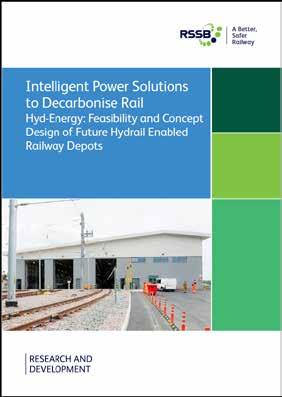
(Above) Aberdeen’s hydrogen production and fuelling station. (Inset) BNSF’s hydrogenpowered shunter.
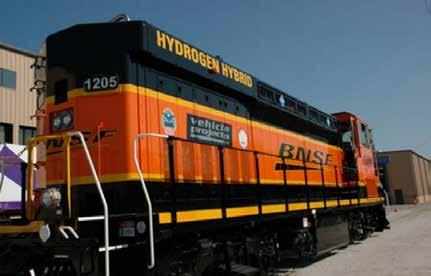
In Aberdeen, a pilot scheme of ten hydrogen buses was supplied by a fuelling station that consisted of three electrolysers (each the size of a 40ft container), two hydrogen compressors and two hydrogen dispensers, together with hydrogen storage, cooling systems and cooling plants.
In total, this plant has a footprint of 32 metres x 26 metres. It required a one-megawatt electricity supply and could supply 300kg of hydrogen per day. Since 2015, the plant has had a 99.9% availability.
The report on this pilot scheme concluded that electrolyser plants are a mature, reliable technology which can easily be scaled up and provide opportunities for grid balancing. The capital cost of the 2015 Aberdeen plant was £1 million, although the report noted that the prices of such plants are continuing to decrease. On this basis, the cost of a hydrogen plant to supply ten trains would be of the order of £10 million.
The report also concluded that the total cost of ownership was £169,000 per bus, which is comparable with battery buses but £62,000 more than for diesel buses. The RSSB report noted that there is potential for significant electricity cost savings if renewable electricity could be generated on site. The cost of the hydrogen would then be the essentially fixed maintenance and capex costs of the required plant.
Although, as yet, there are no operational hydrogen train fuelling plants, two are under construction in Germany. Work on the first, at Bremervoerde in Lower Saxony, started in July. This plant will be built and operated by Linde with completion expected in mid-2021 when it will be able to supply up to 1,600kg of hydrogen per day for a fleet of 14 iLint trains.
Work on the other fuelling station, being built at Hesse in Germany’s Rhine-Maine region, started in October. This will be built and operated by Infraserv Höchst to fuel a fleet of 27 iLints which are expected to be operational from December 2022. This fleet is being supplied by Alstom under a €500 million contract with the local train operator, which includes maintenance and the supply of hydrogen for 25 years. This is perhaps the first rolling stock contract to include a train’s fuel.

Early hydrogen trains
The first annual international Hydrail (hydrogen trains) conference was held in North Carolina in 2005. The following year, the East Japan Railway Company unveiled the world’s first fuel cell hybrid railcar powered by two 95kW fuel cells. The world’s first hydrogen powered locomotive ran in 2010. This was a 130-ton shunting locomotive which was developed by the US Army Corps of Engineers for the BNSF rail freight company, using a 240kW fuel cells provided by Ballard.
The UK saw its first hydrogen rail traction in 2012. This was a 10¼ inch gauge locomotive powered by a 1kW fuel cell, supplemented with batteries to give a total power output of 4.4kW. It was the University of Birmingham’s entry at the first IMechE’s Railway Challenge and part of the University’s ongoing research into hydrogen power. Later that year, the locomotive was showcased at the seventh Hydrail conference, held in Birmingham.
Visitors to InnoTrans in 2016 saw Alstom launch its hydrogen powered Coradia iLint train. This was a converted DMU that had been under development since 2014. In 2018, two pre-production units entered passenger service in Germany and recently successfully completed 180,000 kilometres test running. The iLint is a hydrogen/battery hybrid to smooth the load on the fuel cell, boost traction power when required and provide regenerative braking. Alstom reports that optimising the traction control system was particularly challenging.
In the UK, rail leasing company Porterbrook and the University of Birmingham formed a partnership in 2018 to convert a redundant Class 319 unit into HydroFLEX, a proof-of-concept hydrogen train.
These first hydrogen trains are the result of fuel-cell technology developments to make them significantly more compact and efficient. Thus, hydrogen can now be considered to be a mature and practical technology for use on trains, HGVs and buses, as well as other applications such as mobile plant.
The government’s Committee for Climate Change estimates that achieving net-zero carbon emissions would require an annual hydrogen requirement for HGVs, buses, and trains of respectively 22, 3 and 0.3 TWh. This illustrates the opportunities for synergies with road transport.
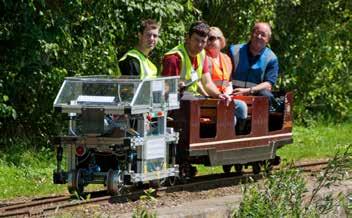
Future international developments
As mentioned above, depot facilities are now under construction for two Alstom iLint fleets in Germany, totalling 41 trains. These units are certified for running in tunnels up to five kilometres long and in covered stations. After being tested in the Netherlands in March and Austria in December 2019, two pre-production iLint units are now operating passenger services in Austria, where the iLint operates on challenging alpine gradients. UK’s first hydrogen train, the University of Birmingham’s entry for the 2012 IMechE Railway Challenge.


(Left) Alstom’s iLint general arrangement. (Below) Alstom’s iLint hydrogen train. (Inset) iLint’s roof mounted fuel cells.

Alstom’s iLint in service in Austria.
Narrow-gauge hydrogen train for the Zillertalbahn railway.
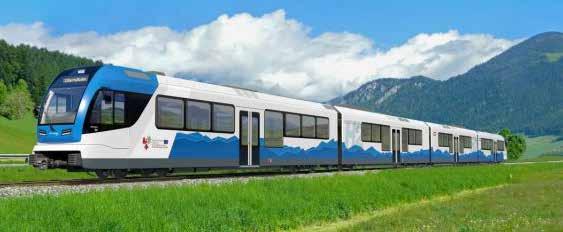
Alstom has also signed an agreement with the Italian energy infrastructure company Snam for the development of hydrogen multiple units (HMU) in Italy. Alstom is also to supply six HMUs to the Italian region of Lombardy based on its Coradia Stream regional train platform. The first one is expected to be delivered by 2024. Meanwhile, in France, the company is developing a hydrogen fuel cell variant of its four-car Coradia Polyvalent unit which will carry 200kg of hydrogen to give it a range of around 500km.
As Alstom unveiled the iLint at Innotrans in 2016, Siemens announced its new Mireo multiple unit platform which provides a lighter and more energy efficient family of trains for commuter and regional train services. The first Mireo EMU entered service in Germany this year. Also this year, Siemens received an order for 20 battery-powered Mireo Plus B units, which will enter service in Germany in 2023.
Siemens is also developing a Mireo plus H variant in partnership with Canadian fuel cell producer Ballard which, by next year, expects to have developed a fuel cell with triple the service life, 50 per cent higher power density and 5 per cent better efficiency than current fuel cells. The Mireo plus H will be as powerful as its EMU variant. Siemens Mobility has also signed an agreement with Siemens Energy to develop an infrastructure solution for fuelling hydrogen trains. Deutsche Bahn and Siemens are planning to test the prototype Mireo hydrogen train in 2024 in the state of Baden-Wurttemberg where a specially designed hydrogen plant will be provided at Ulm.
In 2018, Stadler received an €88m order to supply five hydrogen trains to the 32-kilometre 760mm-gauge Zillertalbahn in Austria. These trains are due to enter service in December 2022, when this will be the world’s first narrow-gauge railway to operate hydrogen trains.
Stadler is also supplying the United States with its first hydrogen train. This will be a two-car FLIRT H2 unit, with the central power car carrying the fuel cells and hydrogen tanks. This unit has been ordered by California’s San Bernardino County Transportation Authority in a contract that has an option to supply a further four vehicles.
In another development, CAF is leading the FCH2RAIL consortium’s €14 million project to develop and test a prototype hydrogen train which will be a modified CAF Civia Class 463 three-car EMU. The project has been awarded a €10 million EU grant. CAF has gained experience of fuel-cell technology through its recently acquired Solaris bus subsidiary.
Other FCH2RAIL consortium members are German aerospace research centre DLR, Spanish train and infrastructure operators RENFE and ADIF, Toyota Motor Europe, Portuguese infrastructure manager IP, Spanish national hydrogen centre CNH2 and rolling stock component supplier Faiveley Stemmann Technik. Work on the four-year project is to begin in January 2021.
The project will explore the use of waste heat from fuel cells to improve energy efficiency and will draft new and updated European technical standards to ensure the interoperability of future hydrogen trains. UK hydrogen train initiatives
In Britain there are three hydrogen trains under development. These are the HydroFLEX being developed by Porterbrook and the University of Birmingham’s Centre for Railway Research & Education (BCRRE), Alstom’s ‘Breeze’ concept and the production of a hydrogen demonstrator train in Scotland.
All three hydrogen trains will be conversions of redundant rolling stock. Recycling trains in this way avoids the embedded carbon associated with the production of new rolling stock. However, it limits available options for the location of hydrogen tanks which, due to the low energy density of hydrogen, take up significant amount of space. This is a particular problem in the UK, with its restricted loading gauge.
To support the Scottish Government’s rail decarbonisation plans, which require large-scale electrification, Scottish Enterprise and Transport Scotland are jointly leading a project to produce a demonstration hydrogen train. This project is intended to develop the capabilities of Scotland’s supply chain and give its educational institutions knowledge of hydrogen fuelcell technology within the rail industry, help deliver the required standards and inform further development of the Scottish rail decarbonisation plan.
A concept design to convert a redundant Class 314 EMU has been produced by Brodie Engineering and Arcola Energy in the first phase of this project. Phase two is producing the train and demonstrating it off Network Rail’s infrastructure. A contract for this phase has been procured by the University of St Andrews through its Hydrogen
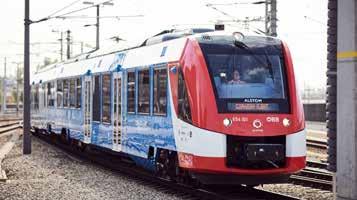
Accelerator innovation centre. The contract, with an estimated value of £2.75 million, has been awarded to a team led by Arcola Energy, which will develop a local, Scottish supply chain as well build and demonstrate the locomotive.
The demonstration unit will also be a showpiece at the global COP 26 environmental conference, which should be held in Glasgow in November 2021.
Class 600 HMU
For Alstom, the challenge is to package their proven hydrogen traction technology within a UK-gauge train and to get sponsors’ acceptance of a commercial package for fleet operation. With the experience of the iLint, a UK prototype would serve little purpose and would need a bespoke arrangement for hydrogen fuelling. Instead, a partnership of Alstom and Eversholt, formed in 2017, are investing £2 million to develop their ‘Breeze’ concept, which was unveiled in 2019, and to prepare Alstom’s Widnes facility to produce a ‘Breeze’ fleet. No external funding has been received for this work.
The Breeze is a three-car unit that is a conversion of a redundant Class 321 EMU. It has two driving trailer coaches, which each have roof mounted fuel cells and interior hydrogen fuel tanks taking up a third of the coach space. The central motor coach has the traction motors and batteries. The unit will have between 148 and 168 standard class seats which is more than the two-car Class 15x DMUs that they will replace.
These trains will be designated Class 600 HMUs and so, as far as numbering is concerned, they will be the first of the 6xx category of units, a new classification for alternatively powered traction.
Following discussions with various potential customers for the Class 600 HMU, it is likely that the first deployment will be in the Tees Valley, where Northern Trains have selected the Class 600 HMU as its preferred solution for the operation of zero-emissions rolling stock. This would initially be a fleet of ten trains operating services to Bishop Auckland, Hartlepool, Saltburn and Whitby. Alstom’s Breeze has hydrogen stored inside the train behind the driver’s cab.
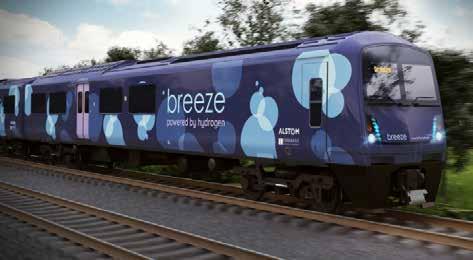
Subscribe to our free publications at
www.railsubs.com
www.geobrugg.com/slope
TECCO® STAINLESS high-tensile steel mesh

SLOPE STABILISATION UNDER CORROSIVE CONDITIONS
Their deployment will be supported by the UK’s first hydrogen transport hub in Teeside. As part of this, it is proposed to build a hydrogen train maintenance facility on the former Lackenby Steelworks site. This will consist of a three-road maintenance shed, stabling for 16 units, train wash and CET facilities along with a hydrogen production and refuelling plant.
Alstom has developed a programme for the detailed design and production of Northern’s fleet of 10 Class 600 HMUs that would see the fleet in service by 2024 if authorisation for the fleet was obtained early in 2021.
HydroFLEX
The University of Birmingham established its centre for Fuel Cell and Hydrogen Research in 2000 to research practical hydrogen applications. This led to the University’s miniature hydrogen locomotives being a regular entrant at the IMechE Railway Challenge. In 2018, its entry was the “Hydrogen Hero” locomotive, and this was also the year that that BCRRE formed a partnership with Porterbrook to develop a full-sized hydrogen demonstrator train.
The resulting HydroFLEX train is a redundant four-car Class 319 unit in which one coach has had its seats and interior fittings removed to house the required equipment. This includes a 100kW Ballard fuel cell, a 650V 84kWh battery pack, four hydrogen tanks storing a total of 20kg of hydrogen at 350bar, the traction control system and other equipment. It took just nine months to modify the Class 319 to enable HydroFLEX to be demonstrated at Rail Live in June 2019.
In May 2019, BCRRE was awarded an Innovate UK grant of £350,000 to undertake mainline testing, which required a complex approvals submission for this novel form of traction. As a result, in September 2020, HydroFLEX was able to run on the mainline at speeds of up to 50mph.
A further Innovate UK grant of £400,000, awarded in May, is now being spent to locate batteries, traction control system and fuel cells underneath the vehicle to reclaim passenger space and to finalise the design of the fuel cell and battery hybrid traction power system. As the HydroFLEX units retains its overhead line traction equipment, the production version will be configured for operation using both overhead electrification and hydrogen on non-electrified routes.
The production version is expected to have a range of 1,000 kilometres, this is the same range as the iLint which has a 90kg hydrogen tank on each vehicle. As the four-car HydroFLEX currently stores 20kg of hydrogen, it remains to be seen whether it will be possible to provide the required range without the hydrogen tanks encroaching into the passenger space.
In addition to the Innovate UK funding, BCRRE and Porterbrook have themselves invested over £1 million in the HydroFLEX project, which they expect to be ready for series production by the end of 2022.
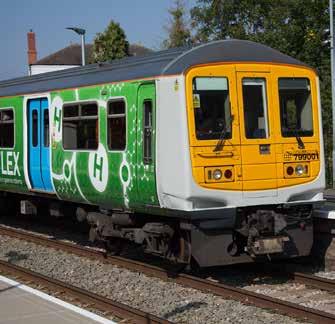
What next?
If rail traction is to be weaned off diesel, hydrogen is the only available alternative traction for passenger services of any distance on nonelectrified lines. However, as the Aberdeen hydrogen bus trial indicates, hydrogen fuel is likely to be more expensive than diesel, although this cost differential should reduce over time. Yet, if the imperative is to eliminate CO2 emissions, it will be difficult to avoid such additional costs. In this respect, including the cost of hydrogen in the train procurement contract, as was done for the Rhine-Maine region’s iLints, might be a way forward.
As this feature shows, hydrogen powered trains in Europe are a mature technology on the cusp of fleet operation. In the UK, a few million pounds of innovation funding is being spent to develop home-grown hydrogen trains. Yet, if hydrogen trains are to make a difference, investment of the order of hundreds of millions on train fleets and their associated hydrogen infrastructure is required. This investment is also needed to replace aging Class 15x diesel trains.
Furthermore, TNDS recommends that hydrogen train operations should commence soon, so as to gain experience and develop best practice for the longer-term introduction of these trains. As this feature shows, getting these trains into service should not require further innovation funding. Instead, it requires investment in a small fleet of hydrogen trains to replacing aging diesel trains. If government accepts this TNDS recommendation, the UK could see passengers travelling on hydrogen trains in 2024.

